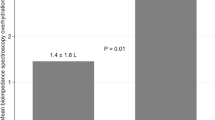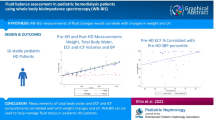Abstract
Background
Achieving and maintaining dry weight appears to be an effective strategy for controlling and maintaining normotension among hypertensive patients on hemodialysis (HD).
Objective
The present study aimed to determine the time at which the majority of patients achieve postdialysis dry weight using bioimpedance spectroscopy (BIS).
Methods
A total of 220 HD patients were prospectively assessed for fluid overload using the Fresenius body composition monitor (BCM). BCM readings were taken at 30 and 45 min postdialysis.
Results
Among the 220 patients included in this study, 120 (54.5%) achieved a euvolemic state at 30 min, and 25 (11.4%) achieved it at 45 min according to the BCM. In the multivariate analysis, vascular access other than arteriovenous fistula (AVF) (OR = 0.286, p value = 0.049) and cardiovascular disease (OR = 0.384, p value = 0.026) had a statistically significant negative association and receiving HD at Hospital Universiti Sains Malaysia (HUSM) (OR = 2.705, p value = 0.008) had a statistically significant positive association with achieving a euvolemic state at 30 min.
Conclusion
This suggests that assessing the hydration status at 45 min postdialysis in all patients or in those with identified risk factors for not achieving a euvolemic state at 30 min will provide a relatively accurate assessment for most patients.

Similar content being viewed by others
References
Kalantar-Zadeh K, Regidor DL, Kovesdy CP, Van Wyck D, Bunnapradist S, Horwich TB et al (2009) Fluid retention is associated with cardiovascular mortality in patients undergoing long-term hemodialysis. Circulation 119:671–679
Agarwal R, Alborzi P, Satyan S, Light RP (2009) Dry-weight reduction in hypertensive hemodialysis patients (DRIP). Hypertension 53:500–507
Wizemann V, Wabel P, Chamney P, Zaluska W, Moissl U, Rode C et al (2009) The mortality risk of overhydration in haemodialysis patients. Nephrol Dial Transplant 24:1574–1579
Chazot C, Wabel P, Chamney P, Moissl U, Wieskotten S, Wizemann V (2012) Importance of normohydration for the long-term survival of haemodialysis patients. Nephrol Dial Transplant 27:2404–2410
Odudu A, McIntyre C (2012) Volume is not the only key to hypertension control in dialysis patients. Nephron Clin Pract 120:c173–c177
Agarwal R (2010) Hypervolemia is associated with increased mortality among hemodialysis patients. Hypertension 56:512–517
Covic A, Onofriescu M (2013) Time to improve fluid management in hemodialysis: should we abandon clinical assessment and routinely use bioimpedance? Clin J Am Soc Nephrol 8:1474–1475
Agarwal R, Weir MR (2010) Dry-weight: a concept revisited in an effort to avoid medication-directed approaches for blood pressure control in hemodialysis patients. Clin J Am Soc Nephrol 5:1255–1260
Dolgos S, Hartmann A, Bollerslev J, Vörös P, Rosivall L (2011) The importance of body composition and dry weight assessments in patients with chronic kidney disease (review). Acta Physiol Hung 98:105–116
Machek P, Jirka T, Moissl U, Chamney P & Wabel P (2009) Guided optimization of fluid status in haemodialysis patients. Nephrol Dial Transplant gfp487
Chongthanakorn K, Tiranathanagul K, Susantitaphong P, Praditpornsilpa K, Eiam-Ong S (2009) Effective determination of dry weight by intradialytic bioimpedance analysis in hemodialysis. Blood Purif 27:235–241
Kotanko P, Levin NW, Zhu F (2008) Current state of bioimpedance technologies in dialysis. Nephrol Dial Transplant 23:808–812
Chamney PW, Krämer M, Rode C, Kleinekofort W, Wizemann V (2002) A new technique for establishing dry weight in hemodialysis patients via whole body bioimpedance. Kidney Int 61:2250–2258
Wabel P, Moissl U, Chamney P, Jirka T, Machek P, Ponce P et al (2008) Towards improved cardiovascular management: the necessity of combining blood pressure and fluid overload. Nephrol Dial Transplant 23:2965–2971
Park J, Yang WS, Kim SB, Park S-K, Lee SK, Park JS et al (2008) Usefulness of segmental bioimpedance ratio to determine dry body weight in new hemodialysis patients: a pilot study. Am J Nephrol 29:25–30
Khan YH, Sarriff A, Adnan AS, Khan AH, Mallhi TH (2016) Chronic kidney disease, fluid overload and diuretics: a complicated triangle. PLoS One 11:e0159335
Devolder I, Verleysen A, Vijt D, Vanholder R, Van Biesen W (2010) Body composition, hydration, and related parameters in hemodialysis versus peritoneal dialysis patients. Perit Dial Int 30:208–214
Wabel P, Chamney P, Moissl U, Jirka T (2009) Importance of whole-body bioimpedance spectroscopy for the management of fluid balance. Blood Purif 27:75–80
Wizemann V, Rode C, Wabel P (2008) Whole-body spectroscopy (BCM) in the assessment of normovolemia in hemodialysis patients. In: Hemodialysis—from basic research to clinical trials. Contrib Nephrol 161:115–118
Moissl U, Arias-Guillén M, Wabel P, Fontseré N, Carrera M, Campistol JM, et al. (2013) Bioimpedance-guided fluid management in hemodialysis patients. Clin J Am Soc Nephrol 12411212
Chen H-S, Lee K-C, Cheng C-T, Hou C-C, Liou H-H, Lin C-J et al (2012) Application of bioimpedance spectroscopy in Asian dialysis patients (ABISAD): serial follow-up and dry weight evaluation. Clin Kidney J 6:29–34
Siriopol D et al (2013) Predicting mortality in haemodialysis patients: a comparison between lung ultrasonography, bioimpedance data and echocardiography parameters. Nephrol Dial Transplant gft260
Siriopol D, Hogas S, Voroneanu L, Onofriescu M, Apetrii M, Oleniuc M et al (2013) Body fluid volume determination via body composition spectroscopy in health and disease. Physiol Meas 27:921
Wieskotten S, Heinke S, Wabel P, Moissl U, Becker J, Pirlich M et al (2008) Bioimpedance-based identification of malnutrition using fuzzy logic. Physiol Meas 29:639
Tai R, Ohashi Y, Mizuiri S, Aikawa A, Sakai K (2014) Association between ratio of measured extracellular volume to expected body fluid volume and renal outcomes in patients with chronic kidney disease: a retrospective single-center cohort study. BMC Nephrol 15:189
Van Biesen W, Williams JD, Covic AC, Fan S, Claes K, Lichodziejewska-Niemierko M et al (2011) Fluid status in peritoneal dialysis patients: the European Body Composition Monitoring (EuroBCM) study cohort. PLoS One 6:e17148
Kuhlmann MK, Zhu F, Seibert E, Levin NW (2005) Bioimpedance, dry weight and blood pressure control: new methods and consequences. Curr Opin Nephrol Hypertens 14:543–549
National Kidney Foundation (NKF) (2006) KDOQI clinical practice guidelines and clinical practice recommendations for 2006. Updates: Hemodialysis adequacy, peritoneal dialysis adequacy and vascular access. Am J Kidney Dis 48:S1–S322
Joseph SM, Cedars AM, Ewald GA, Geltman EM, Mann DL (2009) Acute decompensated heart failure. Tex Heart Inst J 36:510–520
Acknowledgments
We are thankful to the Institute of Postgraduate Studies (IPS) of Universiti Sains Malaysia (USM) for the fellowship support (ref. no. P-FD0011/15(R)).
Funding
Authors have no support or funding for current manuscript.
Author information
Authors and Affiliations
Contributions
Conceived and designed the experiments: AK and AHK. Performed the experiments: AK, AHK, and ASA. Analyzed the data: AK and NA. Contributed reagents/materials/analysis tools: SASS, AK, and SHG. Wrote the paper: AK. Final approval of manuscript: AHK, ASA, and SASS.
Corresponding author
Ethics declarations
Competing interests
The authors declare that they have no competing interests.
Ethics approval
Our study was approved by the Human Resource Ethics Committee of Hospital Universiti Sains Malaysia (USM/JEPeM/16020058). All procedures performed in studies involving human participants were in accordance with the ethical standards of the institutional and/or national research committee and with the 1964 Helsinki declaration and its later amendments or comparable ethical standards.
Informed consent
Informed consent was obtained from all individual participants included in the study.
Additional information
Strengths and limitations of the study
• This study involved heterogeneous group of patients from tertiary-level teaching hospital of Malaysia.
• Use of Fresenius body composition monitor (BCM) for dry-weight analysis.
• To the best of the authors’ knowledge, the current study is strengthened by its prospective nature, and it is the first study to evaluate and suggest the optimal time for dry weight assessments in a clinical setting.
• For determining the predictors of achieving a euvolemic state at 30 min, multivariate analysis was conducted.
• Nevertheless, a multicenter study with a large sample size and longer follow-up time is needed to confirm the findings of the current study.
Rights and permissions
About this article
Cite this article
Khan, A., Khan, A.H., Adnan, A.S. et al. Evaluation of factors affecting time to achieve dry weight among hemodialysis patients using bioimpedance spectroscopy. Ir J Med Sci 188, 311–319 (2019). https://doi.org/10.1007/s11845-018-1813-2
Received:
Accepted:
Published:
Issue Date:
DOI: https://doi.org/10.1007/s11845-018-1813-2




